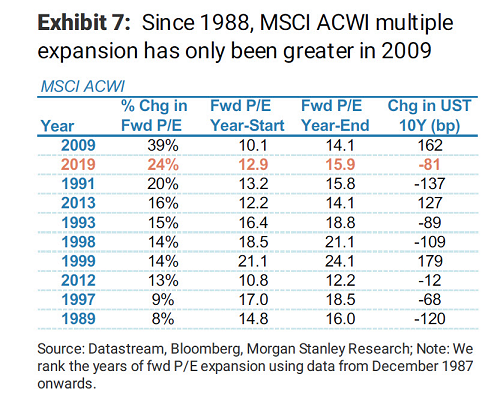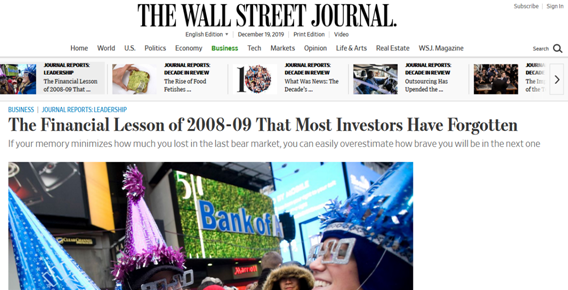Il decennio del dimenticare
Come sempre facciamo, per rispetto sia dei nostri lettori sia del nostro lavoro, ci presenteremo con i numeri a consuntivo appena inizierà il nuovo anno.
Oggi, però, ci siamo dati uno scopo diverso: la nostra intenzione è quella di restituire ai nostri lettori il senso, la sintesi estrema, il significato delle molte cose che hanno seguito, letto ed analizzato con noi nel 2019.
Abbiamo fatto, durante questo weekend un attento lavoro di selezione, e dopo un prolungato dibattito abbiamo scelto l’articolo che segue.
Si tratta di un articolo del Wall Street Journal: una fonte che nessuno, tra i nostri lettori, potrà certo accusare di negatività, pessimismo, disfattismo oppure di avere pregiudizi contro Donald J. Trump. Ed un’autore, Jason Zweig, dalla reputazione ampia quanto la sua fama nel Mondo degli investimenti.
Non ci sentiamo di aggiungere commenti all’articolo: il tema è un tema che Recce’d ha già affrontato in passato. Ovvero: la memoria straordinariamente corta di quasi tutti gli investitori, che mostrano in modo curioso ad ondate sempre più frequenti una sorta di “tendenza suicida collettiva”.
Sono sufficienti 12 mesi di rialzi, per fare ritornare sulle labbra di molti la frase “hanno guadagnato tutti”, e buttarsi come accecati alla rincorsa di un qualche cosa che però, nella realtà, non esiste. Ed è pure semplice da dimostrare, che non esiste. Noi ve lo abbiamo dimostrato, anche in questo Blog.
L’articolo che leggete qui sotto è in inglese: come sempre, vogliamo presentarvelo nella sua integrità, senza aggiungere oppure togliere nulla. Come sempre, chiediamo al lettore che ha poca dimestichezza con l’inglese, di fare un piccolo sforzo.
Non è un grande sforzo: ormai, che le tasse si chiamano “sugar tax” e “plastic tax” (e non ce ne sarebbe alcun bisogno), volte proprio arrabbiarvi con noi di Recce’d per l’inglese? Siate buoni, dai, che è Natale.
If 2000-2009 was the Lost Decade for investors, 2010-2019 was the Decade of Forgetting.
In March 2008, E.S. Browning wrote for The Wall Street Journal that “we may be in another lost decade” for stocks, like the Great Depression and the 1970s. He was right. Stock investors had their wealth slashed in half twice, in 2000-02 and 2007-09. All told, the S&P 500 had an average annual total return of negative 0.95% from 2000 through 2009. To end the decade barely below where they had started, investors had to endure a brutal battering along the way.
Financial markets tend to base their expectations of the future on the experiences of the recent past. At the end of 2009, investors looking back on the prior decade saw that U.S. stocks had gone nowhere; value shares had outperformed growth; small stocks had done better than large; international stocks had beaten U.S. companies; emerging markets had earned higher returns than developed countries.
At year-end 2009, most investors—individuals and professionals alike—expected interest rates to rise, inflation to return, the dollar to weaken, commodities to boom and U.S. stocks to struggle. The giant investment firm Pacific Investment Management Co. and its then-influential co-founder Bill Gross were actively promoting their scenario of “the new normal,” which they described as “likely to be a significantly lower-returning world” for stocks and bonds alike for years to come. (Mr. Gross left Pimco in 2014 and retired from money management earlier this year.)
Instead, over the ensuing 10 years, interest rates fell to historic lows, inflation all but vanished, the dollar strengthened, commodities languished, and U.S. stocks earned among the highest returns they have produced in any decade. What’s more, bonds did well, growth stocks beat value, large stocks beat small, and shares from the rest of the world lagged far behind the U.S.
Investors en masse pulled money out of active funds run by people trying to pick the best stocks or bonds, and poured cash into passive funds run by computers holding everything in a market index. Over the decade, according to Morningstar, investors withdrew more than $160 billion from all active funds combined, while adding more than $3.76 trillion to index funds.
Even so, surprises lurked everywhere. From the market low on March 9, 2009, through the end of that year, the MSCI Emerging Markets index gained 108%. Lured by that spectacular return, investors poured nearly $180 billion into mutual funds and exchange-traded funds specializing in stocks and bonds from developing nations between the end of 2009 and the beginning of 2013, according to data from Morningstar.
Emerging markets proceeded to underperform U.S. stocks by nearly 10 percentage points a year this decade through Dec. 12. Also striking: The MSCI Emerging Markets index has generated a cumulative total return of 42.3% since Dec. 31, 2009—less than half its return from the March 2009 low through the end of that year.
Most investors would likely feel foolish remembering how thoroughly their expectations ended up being repudiated by reality. So they got busy forgetting—both what they expected and what they experienced.
You might have, too. Ask yourself this question, without pausing to deliberate or look up any numbers: How much did my stock portfolio lose during the global financial crisis?
If you’re like most investors I’ve posed that question to over the past few years, you probably answered with something like a 20% to 25% loss.
Yet, from the peak in October 2007 to the bottom in March 2009, U.S. stocks collapsed by 55%; stocks in the rest of the world crashed 59%. (Those numbers include reinvested dividends.) It’s understandable why investors might have blocked such negative memories.
In a 2018 survey for Legg Mason Global Investors, 14% of U.S. respondents said they would invest more in stocks if there were another global market crash on the scale of 2008-09. An additional 28% said they would either “do nothing” or review their investments but not change them.
If your memory minimizes how much you lost in the last bear market, you can easily overestimate how brave you will be in the next one.
Mutual-fund investors, too, have been shown to exaggerate their past returns in both bull and bear markets.
Viewing the past through a rearview mirror made of rose-colored glass is what psychologists call a “positive illusion”: a behavior that helps you sustain your confidence, even if it might not be fully warranted.
That may be good for your mental well-being, but it is likely to be hazardous to your portfolio’s health.
If you forget how eagerly you embraced the market’s most popular strategies a decade ago—small stocks, value stocks, emerging markets, commodities, hedge funds and other “alternative” strategies—then you might be prone to pitches for today’s hottest approaches.
Naturally, many of those are the exact opposite of the prevailing trends from 10 years ago. Nowadays, large U.S. stocks and growth stocks are all the rage. Hedge funds have faded, and foreign investing is less fashionable. Buyout funds run by private-equity firms and venture-capital funds investing in startups are hot. Most investors still flock toward whatever has been working well lately.
Market patterns don’t reverse in 10-year cycles like clockwork; there’s no guarantee that the coming decade will be the opposite of the one that just ended. But before you bet that the future will be like the past, it’s worth remembering that this decade hasn’t turned out the way investors predicted it would 10 years ago.
Mr. Zweig writes The Wall Street Journal’s Intelligent Investor column. He can be reached at intelligentinvestor@wsj.com.


